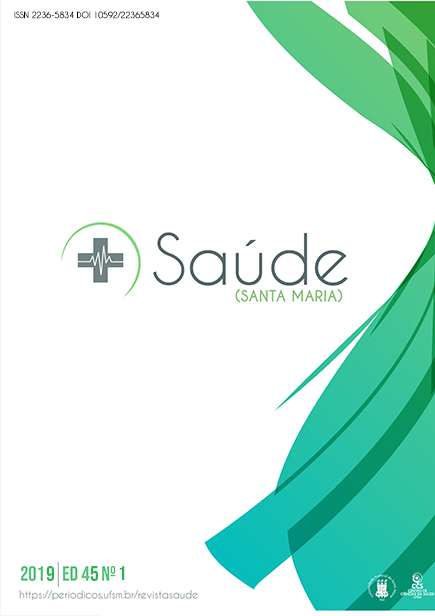Caracterização das impressões plantares em escolares: influência da idade e do indice de massa corporal
DOI:
https://doi.org/10.5902/2236583432450Palavras-chave:
Criança, Adolescente, Pé, Serviços de saúde do escolarResumo
Objetivo: Caracterizar as impressões plantares de escolares conforme o tipo de pé, a idade e o índice de massa corporal (IMC). Método: Trata-se de estudo transversal, realizado com escolares frequentadores de uma Instituição Filantrópica. A amostra foi constituída de 56 escolares, 34 do sexo feminino e 22 do sexo masculino, com idade entre 5 a 12 anos. Foi aferida a massa corporal e a estatura para cálculo do IMC e realizada plantigrafia para obtenção da impressão plantar. A distribuição dos dados foi avaliada pelo teste de normalidade de Kolmogorov-Smirnov. O teste do Qui-quadrado foi utilizado para verificar associações entre variáveis categóricas. As correlações foram realizadas por meio do coeficiente de correlação de Pearson. Foi adotado um nível de significância de 5%. Resultados: A média de idade dos escolares foi de 8,70 ± 1,82 anos e do IMC foi 17,13 ± 2,83 kg/m2. Dentre os 56 participantes, 44,64% obtiveram classificação normal para o tipo de pé, seguidos de 41,08 % com pé plano e 14,28 % com pé cavo. Foi observada moderada e significativa correlação entre idade e o tipo de pé direito (r= -0,45; p=0,00) e pé esquerdo (r= -0,40, p= 0,01) e, também, entre estatura e tipo de pé direito (r= -0,45; p=0,00) e pé esquerdo (r= -0,38, p= 0,01). Conclusão: Os percentuais muito próximos entre o tipo de pé plano e de pé normal demonstram que a postura do pé está se modificando com a idade, conforme o padrão típico de crescimento. Entretanto, a ocorrência de pés cavos é o achado não esperado e que merece mais estudos.
Downloads
Referências
Okamura K, Kanai S, Hasegawa M, et al. The effect of additional activation of the plantar intrinsic foot muscles on foot dynamics during gait. Foot. 2018;34:1–5.
Zuil-Escobar JC, Martínez-Cepa CB, Martín-Urrialde JA, et al. Medial Longitudinal Arch: Accuracy, Reliability and Correlation Between Navicular Drop Test and Footprint Parameters. J Manipulative Physiol Ther. 2018;41(8):672–679.
Uden H, Scharfbillig R, Causby R. The typically developing paediatric foot: How flat should it be? A systematic review. J Foot Ankle Res. 2017;10(1):1–17.
Banwell HA, Paris ME, Mackintosh S, et al. Paediatric flexible flat foot: How are we measuring it and are we getting it right? A systematic review. J Foot Ankle Res. 2018;11(1):1–13.
Chang CH, Chen YC, Yang WT, et al. Flatfoot diagnosis by a unique bimodal distribution of footprint index in children. PLoS One. 2014;9(12):1–11.
Rose KJ, Hiller CE, Mandarakas M, et al. Correlates of functional ankle instability in children and adolescents with Charcot-Marie-Tooth disease. J Foot Ankle Res; 2015;8(1):1–7.
Stolzman S, Irby MB, Callahan AB, et al. Pes planus and paediatric obesity: A systematic review of the literature. Clin Obes. 2015;5(2):52–59.
Chiao Yi L, Soares ALN, Areia M, et al. Influence of body mass index in balance and foot print in obese adults. Rev Bras Med Esporte. 2014;20(1):70–73.
Da Rocha ES, Bratz DTK, Gubert LC, et al. Obese children experience higher plantar pressure and lower foot sensitivity than non-obese. Clin Biomech. 2014;29(7):822–827.
Saldívar-Cerón HI, Garmendia Ramírez A, Antonio M, et al. Obesidad infantil: factor de riesgo para desarrollar pie plano. Bol Med Hosp Infant Mex. 2015;72(1):55–60.
Cavanagh P, Rodgers M. The arch index: a useful measure from footprints. J Biomech. 1987;20(3):547–551.
(WHO) WHO. Growth reference data for 5-19 years. http://www.who.int/growthref/who2007_bmi_for_age/en/index.html. 2007.
Hernandez AJ, Kimura LK, Laraya MHF, et al. Cálculo do índice do arco plantar de staheli e a prevalência de pés planos: estudo em 100 crianças entre 5 e 9 anos de idade. Acta Ortopédica Bras. 2007;15(2):68–71.
Sedwick P. Pearson’s correlation coefficient. Br Med J. 2012;345:1–2.
Vicente E, Longen WC, Machado AM, et al. Pé plano na infância: limites temporais entre o fisiológico e as disfunções locais e ascendentes. Rev Pediatr. 2016;16(3):15–20.
Ueki Y, Sakuma E, Wada I. Pathology and management of flexible flat foot in children. J Orthop Sci. 2019;24(1):9–13.
Martínez-Nova A, Gijón-Noguerón G, Alfageme-García P, et al. Foot posture development in children aged 5 to11 years: A three-year prospective study. Gait Posture. 2018;62:280–284.
Yin J, Zhao H, Zhuang G, et al. Flexible flatfoot of 6–13-year-old children: A cross-sectional study. J Orthop Sci. 2018;23(3):552–556.
Chen KC, Yeh CJ, Kuo JF, et al. Footprint analysis of flatfoot in preschool-aged children. Eur J Pediatr. 2011;170(5):611–617.
Downloads
Publicado
Como Citar
Edição
Seção
Licença
Direito autoral (Copyright): todo o conteúdo do periódico, exceto onde está identificado, está licenciado sob uma Licença Creative Commons Atribuição-NãoComercial-SemDerivações 4.0 Internacional (CC BY-NC-ND 4.0) https://creativecommons.org/licenses/by-nc-nd/4.0/deed.pt_BR/.
A Declaração de Direito Autoral e os itens a serem observados podem ser visualizados abaixo:
1. Política para Periódicos de Acesso Livre
Autores que publicam nesta revista concordam com os seguintes termos:
a) Autores mantém os direitos autorais e concedem à revista o direito de primeira publicação, com o trabalho simultaneamente licenciado sob a Licença Creative Commons Attribution que permite o compartilhamento do trabalho com reconhecimento da autoria e publicação inicial nesta revista.
b) Autores têm autorização para assumir contratos adicionais separadamente, para distribuição não-exclusiva da versão do trabalho publicada nesta revista (ex.: publicar em repositório institucional ou como capítulo de livro), com reconhecimento de autoria e publicação inicial nesta revista.
c) Autores têm permissão e são estimulados a publicar e distribuir seu trabalho online (ex.: em repositórios institucionais ou na sua página pessoal) a qualquer ponto antes ou durante o processo editorial, já que isso pode gerar alterações produtivas, bem como aumentar o impacto e a citação do trabalho publicado (Veja O Efeito do Acesso Livre).
Todo o conteúdo do periódico, exceto onde está identificado, está licenciado sob uma Licença Creative Commons Atribuição-NãoComercial-SemDerivações 4.0 Internacional (CC BY-NC-ND 4.0) https://creativecommons.org/licenses/by-nc-nd/4.0/deed.pt_BR/.






